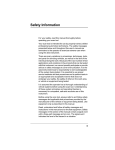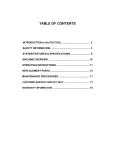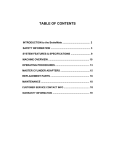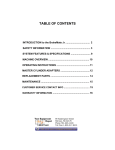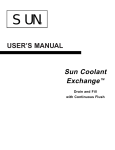Download Important Safety Instructions
Transcript
Important Safety Instructions SAVE THESE INSTRUCTIONS EAZ0042B04C Rev. C ©2011 Snap-on Incorporated All rights reserved. ii Important Safety Instructions For your own safety and the safety of others, and to prevent damage to the equipment and vehicles upon which it is used, it is important that this manual be read and understood by all persons operating, or coming into contact with, the equipment. We suggest you store a copy the book near the unit in sight of the operator. This product is intended for use by properly trained and skilled professional automotive technicians. The safety messages presented throughout this manual are reminders to the operator to exercise extreme care when using this test instrument. There are many variations in procedures, techniques, tools, and parts for servicing vehicles, as well as in the skill of the individual doing the work. Because of the vast number of test applications and variations in the products that can be tested with this instrument, we cannot possibly anticipate or provide advice or safety messages to cover every situation. It is the responsibility of the automotive technician to be knowledgeable of the system being tested. It is essential to use proper service methods and test procedures. It is important to perform tests in an appropriate and acceptable manner that does not endanger your safety, the safety of others in the work area, the equipment being used, or the vehicle being tested. It is assumed that the operator has a thorough understanding of vehicle systems before using this product. Understanding of these system principles and operating theories is necessary for competent, safe and accurate use of this instrument. Before using the equipment, always refer to and follow the safety messages and applicable test procedures provided by the manufacturer of the vehicle or equipment being tested. Read, understand and follow all safety messages and instructions in this manual, accompanying the specific tool, and on the test equipment. Environmental Conditions: • This product is intended for indoor use only • This product is rated for Pollution Degree 2 (normal conditions) Safety Message Conventions Safety messages contain a signal word that indicates the level of the hazard. An icon, when present, gives a graphical description of the hazard. Signal words are: ! DANGER Indicates an imminently hazardous situation which, if not avoided, will result in death or serious injury to the operator or to bystanders. ! WARNING Indicates a potentially hazardous situation which, if not avoided, could result in death or serious injury to the operator or to bystanders. ! CAUTION Indicates a potentially hazardous situation which, if not avoided, may result in moderate or minor injury to the operator or to bystanders. 1 Important Safety Instructions General Safety Instructions Safety messages contain three different type styles. • Normal type states the hazard. • Bold type states how to avoid the hazard. • Italic type states the possible consequences of not avoiding the hazard. An icon, when present, gives a graphical description of the potential hazard. Example: ! WARNING Risk of unexpected vehicle movement. • Block drive wheels before performing a test with engine running. A moving vehicle can cause injury. SAVE THESE INSTRUCTIONS For your safety, read all instructions. Use your diagnostic tools only as described in the tool user’s manual. Use only manufacturer recommended parts and accessories with your diagnostic tools. General Safety Instructions ! WARNING Risk of unexpected vehicle movement. • Block drive wheels with chocks before performing engine running tests. • Unless instructed otherwise, set parking brake, and put gear selector in neutral or park. • Firmly set the parking brake. • If the vehicle has an automatic parking brake release, disconnect the release mechanism for testing and reconnect when finished. • Do not allow bystanders to stand in front of or behind the vehicle while testing. • Do not leave a running engine unattended. A moving vehicle can cause death or serious injury. ! WARNING Risk of accident. • Two people should be in the vehicle when driving on the road, one to drive and the other to attend to the equipment. • If in a moving vehicle, make sure the tester and leads do not interfere with the driver. Accidents can occur when attention is not solely given to driving. ! WARNING Risk of personal injury. • Keep yourself, test leads, clothing, and other objects clear of electrical connections and hot or moving engine parts. • Do not wear watches, rings, or loose clothing when working in an engine compartment. • Do not place equipment or tools on fenders or other places in the engine compartment. • Barriers are recommended to help identify danger zones in the test area. Contact with electrical connections and hot or moving parts can cause injury. 2 Important Safety Instructions General Safety Instructions ! WARNING Risk of explosion. • Wear safety goggles and protective clothing (user and bystander). • Use equipment and tools in locations with ventilation providing at least four air changes per hour. • Flammable fuel and vapors can ignite. • Do not use this system in environments where explosive vapor may collect, such as in below-ground pits, confined areas, or areas that are less than 18 inches above the floor. • Locate this equipment at least 18 inches or more above the floor. • Do not smoke, strike a match, place metal tools or objects on the vehicle battery, or cause a spark in the vicinity of the battery. Battery gases can ignite. • Avoid making an accidental connection between vehicle battery terminals through tools, jumper leads, and other items. • Keep lighted cigarettes, sparks, open flames and other ignition sources away from batteries. • Be sure ignition, headlights, and other accessories are off and that vehicle doors are closed before disconnecting vehicle battery cables. This also helps prevent damage to onboard computer systems. • Do not expose tester to rain, snow, or wet conditions. • Do not allow battery gases or acid to contact tester housing. • Always disconnect battery ground connections before servicing electrical system components. • Keep a dry chemical fire extinguisher (Class B) rated for gasoline, chemical and electrical fires in the work area. Explosion can cause death or serious injury. ! WARNING Risk of fire. • Wear safety goggles and protective clothing (user and bystander). • Relieve fuel system pressure before opening lines and connections. • Keep cigarettes, sparks, open flame, and other sources of ignition away from the vehicle. • Disconnect the battery ground before opening any fuel system fittings. Reconnect the cable to run the engine or operate the fuel pump for testing. • Gasoline, methanol, and oxygenated fuels are toxic and flammable and must be handled appropriately. • Do not position head directly over or in front of carburetor or throttle body. Do not pour gasoline down carburetor or throttle body when cranking or running engine, when working with fuel delivery systems or any open fuel line. Engine backfire can occur when air cleaner is out of normal position. • Do not use carburetor sprays or fuel injector cleaning solvents when performing diagnostic tests. • Keep open containers of flammable liquids, such as gasoline, away from operating equipment. • Keep a dry chemical (Class B) fire extinguisher rated for gasoline, chemical, and electrical fires in work area. Fire can cause death or serious injury. 3 Important Safety Instructions General Safety Instructions ! WARNING Risk of short circuits and burns. • Batteries can produce a short circuit current high enough to weld jewelry to metal. Remove jewelry such as rings, bracelets, and watches before working near batteries. Short circuits and burns can cause injury. ! WARNING Risk of electric shock. • Do not attempt to disassemble any battery or remove any component projecting from or protecting the battery terminals. • Remove the Ground lead from the vehicle battery before removing or disassembling any vehicle electrical component. • Prior to recycling, protect exposed terminals with heavy insulating tape to prevent shorting. • Use extreme caution when working with circuits that have greater than 40 volts DC or 24 volts AC. • Do not use electrical equipment on wet surfaces or exposed to rain. • Always wear properly rated rubber insulated gloves when required or appropriate, particularly when working with voltages exceeding 40 volts DC or 24 volts AC. • Do not operate equipment with damaged cords, damaged cables, or equipment has been dropped or damaged until it has been examined by a qualified service person. Electric shock can cause injury. ! WARNING Risk of burns. • Care must be taken as burns can occur from touching hot parts. • Wear gloves when handling hot engine components. • Do not remove radiator cap unless engine is cold. Pressurized engine coolant may be hot. • Do not touch hot exhaust systems, manifolds, engines, radiators, sample probe, or other hot parts. • Do not place test equipment or tools on fenders or other places in the engine compartment. Engine compartments contain electrical connections. • Keep yourself, test equipment, clothing, and other objects clear of electrical connections. • Tester leads can become hot after extended testing in close proximity to manifolds and other hot parts. Wear gloves when handling hot components. • Do not allow test leads to touch exhaust manifolds or other hot parts. Hot components can cause injury. ! WARNING Risk of poisoning. • Adequate ventilation should be provided when working on operating engines. • Route exhaust outside while testing with engine running. • Use equipment or tools in locations with mechanical ventilation providing at least four air changes per hour. Engine exhaust contains odorless lethal gas. • Use throttle body cleaner only in a well-ventilated area. • Wear protective gloves and safety goggles (user and bystander). • Do not let cleaner contact skin, eyes, or mouth. • Have plenty of fresh water and soap nearby. If throttle body cleaner contacts skin, eyes, or clothing, flush area with soap and water. Poisoning can result in death or serious injury. 4 Important Safety Instructions General Safety Instructions ! WARNING Risk of eye injury. Debris, dirt, and fluids may drop from vehicles. • Knock off any loose debris. Clean surfaces as needed to avoid the potential of falling debris, dirt, and fluids. • Wear approved safety glasses when servicing vehicles. Debris, dirt and fluids can cause serious eye injury. ! WARNING Risk of flying particles. • Wear safety goggles while using compressed air. Compressed air can cause flying particles. • Wear safety goggles while using electrical equipment. Electrical equipment or rotating engine parts can cause flying particles. Flying particles can cause eye injury. ! WARNING Risk of expelling fuel, oil vapors, hot steam, hot toxic gases, acid, refrigerant, and other debris. • Always wear safety goggles and protective clothing (user and bystander). Everyday eyeglasses only have impact resistant lenses; they are NOT safety glasses. • Engine systems can malfunction expelling fuel, oil vapors, hot steam, hot toxic exhaust gases, acid, refrigerant, and other debris. Fuel, oil vapors, hot steam, hot toxic gases, acid, refrigerant, and other debris can cause serious injury. ! WARNING Risk of expelling battery acid. • Wear safety goggles and protective gloves (user and bystander). Everyday eyeglasses only have impact resistant lenses; they are NOT safety glasses. • Make sure someone can hear you or is close enough to provide aid when working near a battery. • Have plenty of fresh water and soap nearby. If battery acid contacts skin, clothing, or eyes, flush exposed area with soap and water for 10 minutes. • Do not touch eyes while working near a battery. • Do not let any material leaked from a battery come in contact with eyes or skin. • Always make sure the battery polarities (+ and –) are correct when installing. Battery acid is a highly corrosive acid that can burn eyes and skin. 5 Important Safety Instructions General Safety Instructions ! WARNING Risk of personal injury or harm. • The Lithium battery used in some tools is factory replaceable only, incorrect replacement may cause an explosion. • Do not expose batteries to excessive heat. • Use batteries from a reputable manufacturer only. • Use only Snap-on provided replacement batteries or battery packs where specified. • Do not change batteries or battery packs while an instrument is attached to a power source. Make sure the unit power is “off” before opening the battery compartment. • When replacing batteries, always replace the whole set. • Do not use different brands of batteries together. • Do not try to recharge batteries that are not specifically designed to be recharged. • Do not allow children to install batteries unsupervised. • Follow the battery manufacturer's instructions for proper handling, storage, and disposal of batteries. • Prior to recycling batteries, protect exposed terminals with heavy insulating tape to prevent shorting. Improper use of batteries can result in personal harm. ! CAUTION Risk of equipment or circuit damage. • Disconnect test leads from any circuit being tested before changing functions. • Always disconnect the live test lead before disconnecting the common test lead. • Do not create an electrical connection between battery terminals with a jump wire or tools. • Do not ground any electrical terminal that has or may have power. • Always unplug equipment from an electrical outlet when not in use. • Never use the cord to pull a plug from an outlet. Grasp the plug and pull it to disconnect. • If an extension cord is necessary, a cord with a current rating equal to more than that of the equipment should be used. Cords rated for less current than the equipment may overheat. • Loop cord or cables loosely around equipment when storing. • Use tools only as described in the tool user’s manual. • Use only the manufacturer’s recommended attachments. Improper equipment use can cause equipment or circuit damage. ! CAUTION Risk of incorrect or improper repair and/or adjustment. • Do not rely on erratic, questionable, or obviously erroneous test information or results. If test information or results are erratic, questionable, or obviously erroneous, check to make sure that all connections and data entry information are correct and that the procedure was performed correctly. • If test information or results are still suspicious, do not use them for diagnosis. Contact Snap-on® Customer Care. Improper repair and/or adjustment may cause vehicle or equipment damage or unsafe operation. ! CAUTION Risk of unsafe condition. • Use only Snap-on power adapters and/or power cables. • Use only the Snap-on adapter that is recommended for a specific product or series of products. Use of non-Snap-on type power adapters or power cables can result in damage or unsafe conditions. 6 Important Safety Instructions All Handheld Diagnostic Tools All Handheld Diagnostic Tools ! WARNING Risk of airbag deployment • Do not place diagnostic tools or any other object between the airbag and a person. An object near the expanding airbag may be propelled at high speed and become a projectile capable of causing serious injury, death, or damage. Airbag deployment can cause death or serious injury. ! WARNING Risk of entanglement. • Do not allow cables to hang in a manner that could entangle operators or driving controls. • Arrange cords so that they will not be tripped over or pulled. • Be sure that cables attached to your tools, equipment, and other accessories are routed so as not to interfere with walk paths. Poorly routed cables and exposed conductors can create an unsafe condition ! WARNING Risk of electric shock. • Disconnect all test leads and turn diagnostic tools off before removing end grips. • Do not operate diagnostic tools without properly installed end grips. • Do not attempt to disassemble any battery or remove any component projecting from or protecting the battery terminals. • Do not remove covers or attempt to disassemble. No user serviceable parts inside. Refer to qualified service personal. Electric shock can cause injury. ! WARNING Risk of injury. • Use care when testing or controlling actuators and other vehicle components. Be sure activating does not create an unsafe condition. User control of actuator and/or functional tests could create unsafe condition. ! WARNING Risk of unexpected vehicle movement. • Block drive wheels with chocks before performing an engine running test. • Unless instructed otherwise, set parking brake, and put gear selector in neutral or park. • Firmly set the parking brake. • Do not allow bystanders to stand in front of or behind the vehicle while testing. • Do not leave a running engine unattended. A moving vehicle can cause death or serious injury. 7 Important Safety Instructions Scan Tools Scan Tools ! WARNING Risk of explosion. • Some tools contain an internal 250V, 8A Fuse (F6) that is factory replaceable only, incorrect replacement may cause an explosion. • Do not use scan tools in environments where explosive vapor may collect, such as in below-ground pits, confined areas, or less than 18 inches (45 cm) above the floor. • Do not expose tester to rain, snow, or wet conditions. • Do not allow battery gases or acid to contact tester housing. • Be sure all test leads are connected as instructed before proceeding with a test. Explosion can cause death or serious injury. Scopes and Meters All scopes and meters fit into one of four Categories based upon the electrical signals they are designed to measure. It is extremely important that the scope or meter selected to perform a test is designed to meet that specific task. Categories are briefly explained below: • Category I—use for testing electronic equipment and equipment connected to source circuits in which measures are taken to limit transient overvoltages to an appropriate low level. Most 12V automotive systems fit this category. • Category II—use for testing single-phase loads connected to a receptacle, such as appliances, portable tools, and similar items. Also use to test household outlets and long branch service that is 30 feet (10 meters) from a Category III source or 60 feet (20 meters) from a Category III source. • Category III—use for testing three-phase distribution, including single-phase commercial lighting. Some automotive hybrid systems and batteries fit this category. • Category IV—use for testing three-phase at the utility connection and any outdoor conductors. Some automotive hybrid systems and batteries fit this category. Scopes and Meters, All Categories ! WARNING Risk of explosion. • Do not use scopes and/or meters in environments where explosive vapor may collect, such as in below-ground pits, confined areas, or areas that are less than 18 inches (45 cm) above the floor. • Do not allow battery gases or acid to contact tester housing. • Be sure all test leads are connected as instructed before proceeding with a test. • Remove the amp probe when not in use. Explosion can cause death or serious injury. 8 Important Safety Instructions Scopes and Meters ! CAUTION Risk of equipment or circuit damage. • Disconnect test leads from any circuit being tested before changing functions. Always disconnect the live test lead before disconnecting the common test lead. • Never perform resistance, diode, or polarity tests on a live circuit. • Unless specifically directed by the test procedure, make sure the ignition is off before connecting or disconnecting connectors or any vehicle electrical terminals. • Remove the amp probe when not in use. • Do not create an electrical connection between battery terminals with a jumper wire, or your scopes and/or meters. • Do not ground any electrical terminal that has or may have power. • Do not allow battery gases or acid to contact tester housing. Improper use can cause equipment or circuit damage. Scopes and Meters, Category I ! WARNING Risk of electric shock. • This product is intended for Measurement Category I (for example, automotive 12V systems), do not use this product for Measurement Categories II, III, and IV. • Measurement Category I is for measurements performed on circuits not directly connected to MAINS or MAINS circuits (an example of MAINS circuit is 120V AC or 240V AC household or industrial electricity). • Do not connect this product to MAINS or MAINS circuits. • Do not exceed voltage limits between inputs as indicated on the rating label. • Use extreme caution when working with circuits that have greater than 40 volts AC or 24 volts DC. • Do not apply more than 75 volts DC or 50 volts AC between inputs as indicated on the rating label on the diagnostic tool unit. • The serial port is electrically isolated from other inputs however, do not allow a voltage differential greater than 75 volts DC or 50 volts AC to develop between the serial port and any other input. • Do not attempt to connect your scopes and/or meters to a PC USB port while measuring signals with the test leads. • Do not connect Inductive RPM Pickup, Secondary Ignition Clip-on Wire Adapter, or any other probe to damaged or un-insulated conductors. • Do not use scope or multimeter on Hybrid electric vehicle high-voltage systems, batteries, or circuits. Electric shock can cause injury. ! CAUTION Risk of equipment or circuit damage. • Do not use scopes or meters to perform tests on household or industrial sources. Improper use can cause equipment or circuit damage. 9 Important Safety Instructions All Wireless Communication Devices Scopes and Meters, Categories III and IV ! WARNING Risk of electrical shock. • This product is intended for Measurement Category III (1000V) and IV (600V). • Do not exceed voltage limits between inputs as indicated on the rating label. • Use extreme caution when working with circuits that have greater than 40 volts DC or 24 volts AC. • Do not connect Inductive RPM Pickup, Secondary Ignition Clip-on Wire Adapter, or any other probe to a damaged or un-insulated conductors. • Always wear properly rated rubber insulated gloves when required or appropriate, particularly when working with voltages exceeding 40 volts DC or 24 volts AC. • Use only appropriate (Category III or IV) Snap-on components, such as test leads, scope leads and auxiliary components with meter and scope products. Do not use aftermarket “equivalents” or alternate leads of unknown origin. • Use only Snap-on suggested components that are in good working order. Do not use components that show extreme wear or are visibly damaged. Make sure the components are properly rated for the task. • Always examine the instrument for signs of damage before use. Do not use devices that show cracks or other defects that may allow for high voltage exposure. Electrical shock can cause personal injury, equipment damage, or circuit damage. All Wireless Communication Devices ! WARNING • To comply with Federal Communications Commission (FCC) radio frequency (RF) exposure requirements, a separation distance of 20 cm (7.87 inches) or more must be maintained between the antennas and all persons. SAVE THESE INSTRUCTIONS 10












